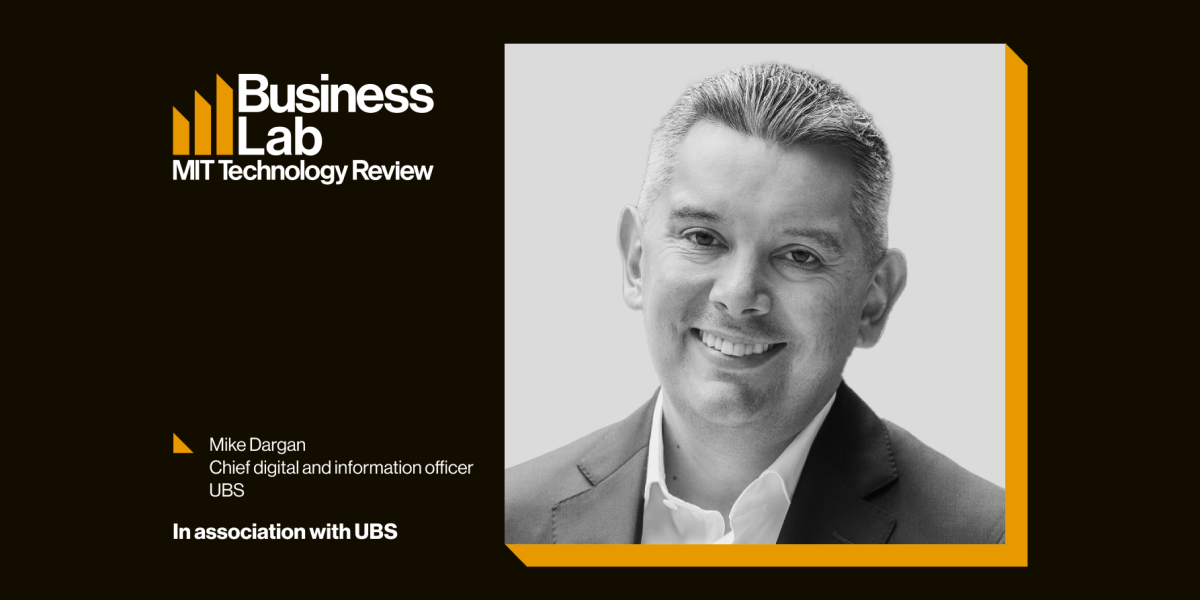
So then if I extend that. Two years ago, we launched DevCloud, UBS DevCloud, which is effectively an open ecosystem built on public cloud, where all our software engineers can have a seamless experience going from dev, to test, to deploy solutions while they’re running. That accelerates time to market, it decreased cost as well, which obviously impacts clients. With DevCloud, we can also constantly improve our apps, so they will never be 10 years old, but instead they will continue to be relevant.
Now, the biggest benefit as well of moving to the cloud is that things that used to take, say, five days, now only take one, which helps boost our engineers’ productivity and makes it a great place to work. We have an expression here we use quite a lot, which is, “All engineers, all developers wait at the same speed.” So, anything we can do to reduce their waiting time is value added. If we have the best engineering talent, if we have the best platforms, we can create the best experience for our clients, in terms of how they engage and interact with us.
Laurel: You mentioned cloud computing, and to create a more definitive timeline here, in late 2018 UBS announced a plan to make the firm more effective and efficient through cloud computing. Then as of February 2021, it was well ahead of that schedule, with 50% of computing happening on private and public cloud. So obviously, a huge transition, if you’re talking, just in 2016, about mainframes, but what has that shift to the cloud allowed the company to do?
Mike: The strategy we set at the end of 2018 was to move, within four-ish years, towards a cloud setup that was a third, a third, a third. So, a third hosted on private cloud, a third public cloud, and a third on mainframe. And we wanted super clear objectives, to try and transition and transform the organization, and how we then progress and what that means. We are ahead of schedule of what we want to do. I also would say our progress in cloud prepared us for the unpredictable, and we’ve seen that through COVID, we’ve seen it through surge volumes, which happened in high vol, due to some of the situations in the world. We need greater capacity in dealing with high trading volumes, and with cloud, you have burst elasticity, because you can burst out for extra capacity. At the same time, we were always able to ensure that business-critical applications are stable, and actually, our availability is above 99.999%. So, the five nines of availability, and that really places us among the leaders in the financial industry.
Also, because we had our cloud-based employees set up, which we call A3, anytime, anywhere, from any device, which is now workspace, we enabled 95% of our employees to work from home. So, we saw more than 60,000 users logged in simultaneously, a huge increase in use of comms tools, so 3 million Skype calls a week. Cloud ultimately makes us more flexible, more stable, more transparent, I think our facilitation with other ecosystems is much easier. All this is great for our clients. It is something I keep repeating, even the piece that seems not client-related means that we can respond faster to their needs and actually maintain security.
Laurel: Part of this initiative across the company to think more strategically about those tech investments, UBS recently joined the Green Software Foundation as a steering member, in part to support the company’s push also for net zero greenhouse gas emissions across all of its operations by 2050. So how does joining the Green Software Foundation affect the choices you make when building and deploying software?
Mike: Yeah, I mean, at a strategic level, UBS is absolutely committed to sustainability, and I think as an individual, but also as a GEB member, it’s a priority overall. We have thousands of applications running across our global business, and I think one of our big steps in our evolution is not just accelerating our digital transformation, but how do we do it in the right way? So how do we use those greener development principles as a huge part, an integral part, of our approach going forward?
We’ve made advances in reducing our carbon emission, and that can be moving from on-prem data centers to the cloud, or reducing, or actually removing idle, power-hungry resources. Now, we’re also looking more and more at whether we can use carbon aware applications and then users can take options with the lowest emission. The Green Software Foundation is a really cool group, partnering with them to share the best practice and knowledge with other members is part of that journey to continue cutting carbon emissions. I think we, with others, can really lead the way here.
